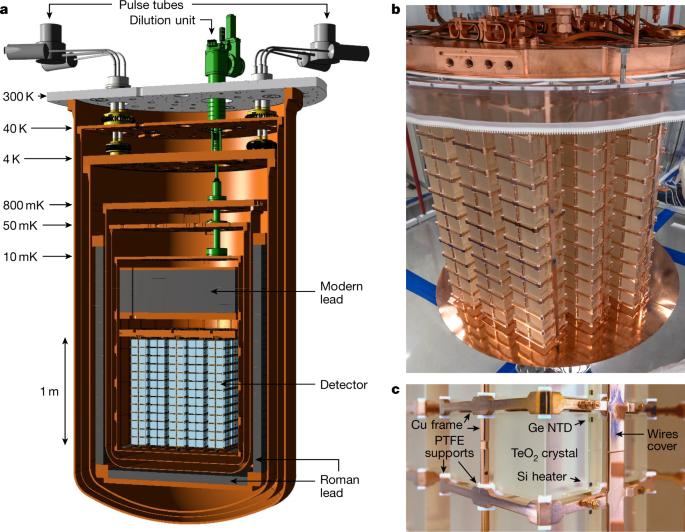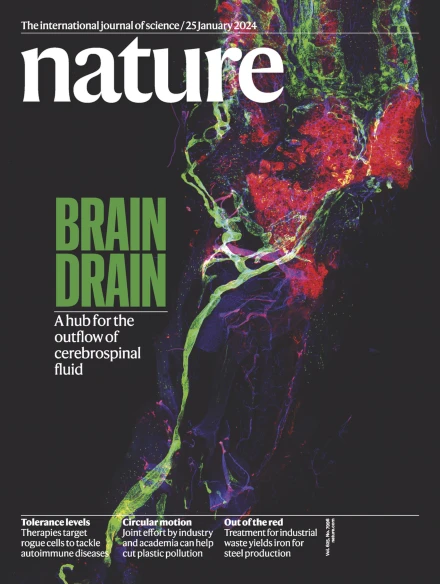用CUORE寻找利用毫开尔文低温的马约拉纳中微子
IF 50.5
1区 综合性期刊
Q1 MULTIDISCIPLINARY SCIENCES
引用次数: 71
摘要
埃托雷-马约拉纳(Ettore Majorana)于 1937 年提出的费米子对称理论1 提出了中微子可能是自身反粒子的可能性,这在已知的基本粒子中是独一无二的。鉴于这种马约拉纳中微子的深远影响,其中包括通过轻生成可能解释宇宙物质与反物质的不对称2,中微子的马约拉纳性质在全球范围内引起了强烈的实验关注;其中一个主要的实验探测器是无中微子双β(0νβ)衰变。在这里,我们展示了利用最新的先进低温量热仪和 CUORE 实验3 搜索 130Te 的 0νββ 衰变的结果。CUORE 的工作温度仅比绝对零度高 10 毫开尔文,它在三个方面推动了技术的发展:在如此超低的温度下保持的质量、工作寿命以及低温基础设施产生的低水平电离辐射。我们没有发现 0νββ 衰变的证据,并将过程半衰期的下限设定为 2.2 × 1025 年,可信区间为 90%。我们讨论了 CUORE 取得的进展在其他领域的潜在应用,如直接暗物质、中微子和核物理搜索以及大规模量子计算,这些领域可以从大型有效载荷在低辐射、超低温低温环境中的持续运行中获益。CUORE 实验发现,在 10 毫开尔文温度的极端低辐射环境中稳定运行大型低温 TeO2 热量计数年后,没有证据表明存在无中微子双贝塔衰变。本文章由计算机程序翻译,如有差异,请以英文原文为准。

Search for Majorana neutrinos exploiting millikelvin cryogenics with CUORE
The possibility that neutrinos may be their own antiparticles, unique among the known fundamental particles, arises from the symmetric theory of fermions proposed by Ettore Majorana in 19371. Given the profound consequences of such Majorana neutrinos, among which is a potential explanation for the matter–antimatter asymmetry of the universe via leptogenesis2, the Majorana nature of neutrinos commands intense experimental scrutiny globally; one of the primary experimental probes is neutrinoless double beta (0νββ) decay. Here we show results from the search for 0νββ decay of 130Te, using the latest advanced cryogenic calorimeters with the CUORE experiment3. CUORE, operating just 10 millikelvin above absolute zero, has pushed the state of the art on three frontiers: the sheer mass held at such ultralow temperatures, operational longevity, and the low levels of ionizing radiation emanating from the cryogenic infrastructure. We find no evidence for 0νββ decay and set a lower bound of the process half-life as 2.2 × 1025 years at a 90 per cent credibility interval. We discuss potential applications of the advances made with CUORE to other fields such as direct dark matter, neutrino and nuclear physics searches and large-scale quantum computing, which can benefit from sustained operation of large payloads in a low-radioactivity, ultralow-temperature cryogenic environment. The CUORE experiment finds no evidence for neutrinoless double beta decay after operating a large cryogenic TeO2 calorimeter stably for several years in an extreme low-radiation environment at a temperature of 10 millikelvin.
求助全文
通过发布文献求助,成功后即可免费获取论文全文。
去求助
来源期刊

Nature
综合性期刊-综合性期刊
CiteScore
90.00
自引率
1.20%
发文量
3652
审稿时长
3 months
期刊介绍:
Nature is a prestigious international journal that publishes peer-reviewed research in various scientific and technological fields. The selection of articles is based on criteria such as originality, importance, interdisciplinary relevance, timeliness, accessibility, elegance, and surprising conclusions. In addition to showcasing significant scientific advances, Nature delivers rapid, authoritative, insightful news, and interpretation of current and upcoming trends impacting science, scientists, and the broader public. The journal serves a dual purpose: firstly, to promptly share noteworthy scientific advances and foster discussions among scientists, and secondly, to ensure the swift dissemination of scientific results globally, emphasizing their significance for knowledge, culture, and daily life.
 求助内容:
求助内容: 应助结果提醒方式:
应助结果提醒方式:


